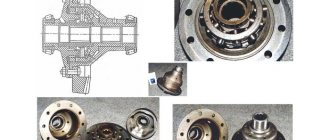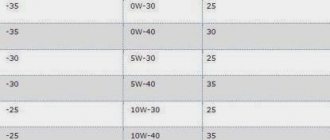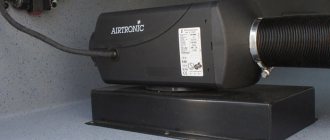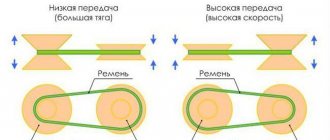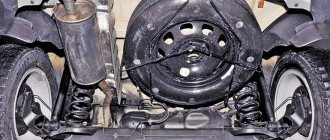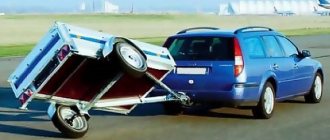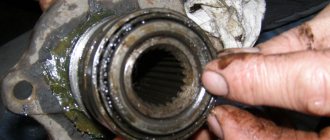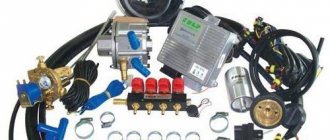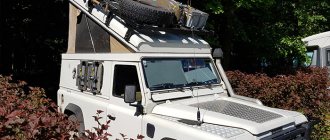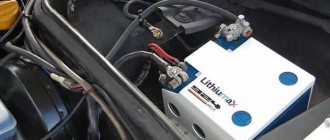Function
In general, a hub is the central part of a rotating part that serves as an attachment point to a shaft or axle. In the first option, the fit or connection is made using a key or splines to transmit torque. The part is attached to the axle through a rolling or sliding bearing. In mechanical engineering, a hub is made for gears, pulleys, and flywheels.
The car's design also includes a hub, which is responsible for securing the front and rear wheels. The part is part of the vehicle’s suspension and is attached to support bridges, beams and levers. The main function of the element is to hold the brake disc (drum), wheel, and transmit torque. The hub assembly absorbs large radial and axial loads. The first is the result of supporting the weight of the car and overcoming obstacles in the form of potholes on the roads. Axial impact occurs when entering a turn and lateral displacement of the machine.
Due to high dynamic loads, the element is made from an all-metal steel blank. Typically, at the factory, the workpiece is first poured into a special mold, followed by turning. The finished hub looks like a metal disk with mounting holes and a seat for a bearing. Depending on the purpose, a hole can be made in it (simple or for a splined shaft) or a blind bushing can be made.
Design
The support unit consists of a wheel hub, attachment, and rolling bearings.
All its components are manufactured with a high degree of precision. Even minor gaps can lead to destruction of the unit. The hub is attached to the suspension through an angular contact ball or roller bearing. To fix the latter, locking rings or castle nuts are used to prevent spontaneous unscrewing. For your information!
Depending on the installation location and the type of vehicle drive, it is possible to mount the hub on one or two bearings. In the first case, a single-row ball or roller bearing is used.
The design of the wheel hub depends on the type of vehicle drive and installation location. There are 4 main design options for the component:
- Driving unsteered wheels. Such elements are installed on the rear axles of cars with full or partial drive. The unit is represented by a long axle shaft that engages with the differential parts, on which a mounting flange and a wheel bearing are attached.
- Driven unsteered wheels. Used in the rear suspension of front-wheel drive cars. The hub assembly consists of a mounting flange mounted on bearings. The element is attached to the longitudinal or transverse beams of the rear suspension.
- Driving steered wheels. This type is installed on cars with full or partial drive. The front hub serves not only to support the wheel, but also to transmit torque from the transmission. It is hollow with an internal spline.
- Driven steered wheels. Hub units are used in the design of the front suspension of rear-wheel drive cars. The parts are secured to the steering knuckle using a threaded connection, and the gaps in the elements can be adjusted by tightening the lock nut.
The main part in the hub assembly is the bearing. It is he who perceives all static and dynamic loads. The durability of the entire mechanism depends on its resource. Manufacturers producing bearings indicate a component service life of about 200 thousand km. This number is quite arbitrary and depends on the nature of driving, as well as the condition of the road surface. When driving off-road, the mileage is reduced to 50 thousand km. At the end of its service life, the bearing must be replaced.
To increase comfort and reduce noise in a car, manufacturers are trying to reduce the unsprung weight of the suspension. To achieve this, the bearing and hub were combined into a single structure. A total of 5 generations of new nodes have been developed:
- Double row bearings type HUB-I. Such parts can be replaced separately, which increases the maintainability of the structure.
- Bearings with mounting flange HUB-II. One of the parts’ holders is made in the body of the hub or fastening element.
- Hub assembly HUB-III. The third generation has received the most widespread use in cars of recent years of production. There is no longer a bearing as such in the unit, but there is a hub and a fastening element, separated from each other by rolling bodies.
- An integrated CV joint was added to the 3rd generation design, receiving HUB-IV technology.
- Hub unit with constant velocity joint and brake disc (HUB-V).
For your information!
4th and 5th generation technologies are under development and testing. The hub units have minimal unsprung mass, which has a positive effect on the performance of the suspension. However, due to the complexity of the design, these generations have a high price, which means they will be installed on premium cars.
Do-it-yourself rear wheel bearing replacement
The rear wheel bearing is a very important element of the rear wheel rotation mechanism. The main task of the bearing is to ensure that the wheel rotates smoothly. In this article we will look at how to replace the rear wheel bearing with your own hands, so as not to go to a service station, where they will charge normal money for the work.
When an unpleasant knocking sound appears in the area of the rear wheels, mainly on uneven surfaces or small potholes, and on a flat road a characteristic hum is a message to the motorist that the rear wheel bearing is faulty and requires replacement. I do not recommend delaying repairs, as this breakdown can drag down other components and assemblies of the car.
Video. Do-it-yourself rear wheel bearing adjustment
Note that in the previous article we looked at malfunctions of the idle speed sensor, its operation and do-it-yourself replacement. Due to incorrect idle adjustment, your car may experience problems with increased fuel consumption, so I recommend paying attention to this article.
How can you tell if your rear wheel bearing needs to be replaced?
The main reason for rear wheel bearing failures is our most beloved domestic roads, which are simply in terrible condition. Road bumps and potholes simply knock out the bearing, and it quickly becomes faulty. Another reason that has become quite popular in recent years is the low quality material from which the bearing is made. Replacing the rear wheel bearing on a car yourself is a fairly simple repair that can be done in a garage.
Video. DIY rear wheel hub bearing installation
How can you tell if the problem is with the rear wheel bearing? Everything is very simple, you need to jack up the side where the knocking or hum is coming from, take the wheel with your hands and swing it. This way we will check for wheel play and if any is found, immediate replacement is required. A faulty bearing can damage the rest of the system in the hub.
It is worth noting that the key to success will be the correct selection of tools and high-quality bearings, on which we do not recommend saving money. You need to make a purchase in reliable stores that have a good reputation and customer reviews. We recommend that owners of foreign cars read https://nur-spare.ru/info/poleznoe/kupit-zapchasti-na-sitroen which spare parts should be purchased only original ones, and which ones can be replaced with analogues from reliable manufacturers.
Replacing the rear wheel bearing - step-by-step instructions
We will need the following tool:
– jack; – nut puller; – mount; – chisels; – wheel wrench; – lithol; – screwdriver.
Procedure:
The first step is to place the car in 1st gear and place supports under the front wheels. Then you need to use a jack - lift the rear of the car and remove the wheel. Unscrew the guide pins and remove the brake drum.
Video. How to replace a rear wheel bearing with your own hands
Having previously prepared a special puller, unscrew the hub nut and knock the hub itself off the axle. It should come out along with our bearing ring. If it doesn’t work, a chisel and a pry bar are used.
To remove the faulty bearing, we need to take special pliers and remove the retaining ring, then knock down the metal boot. Pre-lubricate the seat and install a new bearing. It is worth noting that installation must be done carefully so as not to damage the new part.
It's time to return the metal boot and retaining ring to their rightful place. Carefully apply the remover along the inner ring of the bearing, putting the hub on the axle. We tighten the axle, install the brake pads, drum and put the car wheel in place. The DIY rear wheel bearing replacement was successfully completed, the whole process took about two hours.
Possible defects, reasons for their occurrence
The failure of the hub assembly does not occur instantly. Usually defects appear gradually. They are accompanied by an increase in the clearance in the bearing, which leads to play and runout of the wheel. Main types of hub malfunction:
- Destruction of the cage or rolling elements. This usually occurs due to poor quality materials or a violation of the bearing assembly technology. In addition, destruction is possible due to improper installation of the unit.
- Development of contact surfaces. Bearing parts inevitably wear out, however, the intensity of the process depends on the hardness of the material from which they are made.
- Loosening of fastenings. The design of the mechanism includes locking rings and nuts. If they become loose, the bearing assembly may become loose.
- Dry or lack of lubrication. Without a lubricant, the wear rate will increase several times, which will lead to premature failure of the elements.
- Ingress of dirt or abrasive materials. If the seal is broken, foreign substances contribute to the rapid destruction of parts.
It is difficult to predict what exactly will break. It all depends on the car model, the design features of the hub unit, and the components used. You should not operate the car if there is a suspicion that the chassis components are damaged. Increased clearances in the wheel support lead to increased dynamic loads on suspension components (balls, ends, struts, shock absorbers and other less significant parts). In addition, hub failure while driving can cause loss of control and an accident.
Standard hub sizes
Different car models are equipped with hubs of different diameters. But the rule must always be observed that the hub cylinder can be installed on the wheels with a minimum tolerance. There is a so-called DIA system that sets the diameters of car wheels. If the wheels are smaller than the required size, they will not be able to be installed on the hub. If the wheels are larger, they will simply dangle. Sometimes manufacturers make wheels with fairly large diameters. True, to correctly install the disk on the hub, you have to use special adapter rings. In this case, these adapter rings help ensure that the wheel is centered on the hub.
Signs of defects, their diagnosis
To prevent complete failure of the hub assembly, when the wheel stops rotating or even falls off, the driver needs to pay attention to signs of failure.
The latter appear gradually. First, an indistinct hum appears during acceleration or braking, then the noise does not subside even when driving evenly on a flat road. More severe damage is expressed by grinding and whistling. When a bearing fails, there is excessive tread wear and heating of the brake rotor. For your information!
Unit malfunctions are difficult to diagnose at the first stage of their occurrence. To exclude failure, it is necessary to periodically carry out checks at stations where there is special equipment.
When the first obvious signs appear that the hub assembly is not working correctly, you need to diagnose the parts. You can do this yourself in several ways:
- Tap the side of the tire with your foot. This is a simple but effective method: if the wheel is noticeably wobbly, there is play in its fastenings.
- Check in motion. If at a car speed of 60 km/h and above a monotonous hum appears, wobbling from side to side, you can determine which unit has a defect. When turning left, the right axle is loaded and vice versa. If the sound subsides during the maneuver, it means that this particular hub needs to be repaired.
- Raise the wheel. It is necessary to raise the car with a jack or on a lift and check the play and movement of each hub. When applying lateral force to the wheel, the latter should not dangle or knock. In addition, when rotating, rustling sounds and humming in the bearing are unacceptable.
